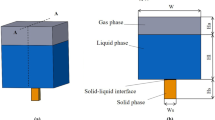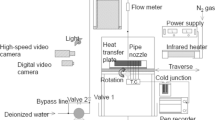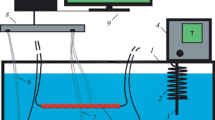Abstract
An experimental study was carried out to investigate the effects of heat transfer surface orientation and the solid–liquid contact angle on the boiling heat transfer and critical heat flux (CHF) in water pool boiling using a smooth heat-transfer surface under atmospheric pressure. The orientation angle was ranged from 0° (up-facing horizontal position) to 180° (down-facing horizontal position) with a pace of 45°. The three kinds of heat transfer surfaces having different solid–liquid contact angles were the normal surface with a contact angle of 55°, the hydrophilic surface with a contact angle of 30° and the superhydrophilic surface with a contact angle of 0°. The experimental results indicate that orientation and contact angle have complex, coupling effects on heat transfer and CHF. A predicting correlation for the CHF which takes the effects of both orientation and contact angle into account is established. The predicting correlation agrees reasonably well with the experimental data.






Similar content being viewed by others
Abbreviations
- Q :
-
heat flux (w/m2)
- ΔT :
-
temperature difference (K)
- h :
-
heat transfer coefficient [W/(m2 K)]
- g :
-
gravity (m/s2)
- h fg :
-
latent heat evaporation (J/kg)
- p :
-
pressure (Pa)
- q m :
-
critical heat flux (w/m2)
- q m,Z :
-
the CHF on the horizontal upward metal surface by the correlation of Zuber (Eq. 3) (w/m2)
- ΔT sat :
-
superheat of heat transfer surface (K)
- r :
-
standard roughness (μm)
- λ :
-
thermal conductivity [w/(mK)]
- δ :
-
thickness (m)
- σ :
-
surface tension (N/m)
- ν :
-
kinematics viscosity (m2/s)
- θ :
-
orientation (degree)
- β :
-
solid–liquid contact angle (degree)
- ρ :
-
density (kg/m3)
- ε :
-
average thickness of vapor layer (m)
- l :
-
liquid
- g :
-
vapor
References
Ramilison JM, Sadasivan P, Lienhard JH (1992) Surface factors influencing burnout on flat heaters. ASME J Heat Transf 114(1):287–290
Kandlikar SG (2001) A theoretical model to predict pool boiling CHF incorporating effects of contact angle and orientation. J Heat Transf 123(6):1071–1079
Takata Y, Hidaka S, Cao JM, Nakamura T, Yamamoto H, Masuda M, Ito T (2005) Effect of surface wettability on boiling and evaporation. Energy 30(2–4):209–220
Wen DS, Wang BX, Peng XF (2001) The influence of surface wettability on boiling crisis. J Tsinghua University (Sci Technol) 41(4–5):128–130
Xiao BQ, Yu BM (2007) A fractal model for critical heat flux in pool boiling. Int J Therm Sci 46(5):426–433
Vishnev IP (1974) Effect of orienting the hot surface with respect to the gravitational field on the critical nucleate boiling of a liquid. J Eng Phys (Translated from Inzhenerno Fizicheskii Zhurnal) 24:43–48
El-Genk MS, Guo A (1993) Transient boiling from inclined and downward-facing surfaces in a saturated pool. Int J Refrigeration 16(6):414–422
Chang JY, You SM (1996) Heater orientation effects on pool boiling of micro-porous-enhanced surfaces in saturated FC-72. ASME J Heat Transf 118:937–943
Yang SH, Baek WP, Chang SH (1997) Pool-boiling critical heat flux of water on small plates: effects of surface orientation and size. Int Commun Heat Mass Transf 24(8):1093–1102
Brusstar MJ, Merte H (1997) Effects of heater surface orientation on the critical heat flux–II. A model for pool and forced convection subcooled boiling. Int J Heat Mass Transf 40(17):4021–4030
Howard AH, Mudawar I (1999) Orientation effects on pool boiling critical heat flux (CHF) and modeling of CHF for near-vertical surfaces. Int J Heat Transf 42(9):1665–1688
Arik, Bar-Cohen (2001) Ebullient cooling of integrated circuits by Novec fluids. In: Proceeding of the Pacific Rim Intersociety, Electronics Packaging Conference. Hawaii 13–18
El-Genk MS, Bostanci H (2002) Saturation boiling of HFE-7100 from a copper surface, simulating a microelectronic chip. Int J Heat Mass Transf 46:1841–1854
Priarone A (2005) Effect of surface orientation on nucleate boiling and critical heat flux of dielectric fluids. Int J Therm Sci 44(9):822–831
Liu ZH, Qiu YH (2005) Critical heat flux of steady boiling for water jet impingement in flat stagnation zone on superhydrophilic surface. J Chem Ind Eng 56(12):2271–2275
Kutateladze SS (1951) A hydrodynamic theory of changes in the boiling process under free convection conditions. Isv Akad Nauk, SSSR, Otd Tekhn Nauk 4:529–935
Zuber N (1958) On the stability of boiling heat transfer. ASME J Heat Transf 80:711–720
Acknowledgment
Special thanks are given to the instrument analysis center of Shanghai Jiaotong University for roughness measurement in this research.
Author information
Authors and Affiliations
Corresponding author
Rights and permissions
About this article
Cite this article
Liao, L., Bao, R. & Liu, Z. Compositive effects of orientation and contact angle on critical heat flux in pool boiling of water. Heat Mass Transfer 44, 1447–1453 (2008). https://doi.org/10.1007/s00231-008-0384-6
Received:
Accepted:
Published:
Issue Date:
DOI: https://doi.org/10.1007/s00231-008-0384-6




